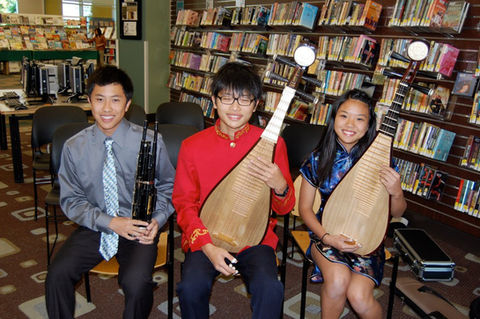Cassie Chen Music

CASSIE CHEN
Musician based in Los Angeles
Traditional Chinese & Western Instruments
Piano, Guzheng, Pipa, Zhongruan, Erhu, Dizi, Hulusi, Flute, Chinese Drums, Percussion, Drumset, Yangqin, Zhong Hu, Gao Hu, Ban Hu, and Zhong Erhu
Image Gallery
Performances & Appearances























Instruments
Chinese Musical Instruments
_jfif.jpg)
Erhu 二胡
Chinese Violin
Erhu 二胡 is a Chinese 2-stringed, vertical fiddle that has a history of more than 1000 years. With a range of about three octaves, it’s sound is rather like a violin, but having a more nasal tone. There are two strings, with the bow inserted between them. There is a vertical post with a fingerboard, which goes through the sides of a resonator at its base. This resonator is covered with a piece of stretched snakeskin (python), which results in the unique “whining” tone color of the instrument. The erhu is almost always tuned to the interval of a fifth. The inside string (nearest to player) is generally tuned to D4 and the outside string to A4. This is the same as the two middle strings of the violin. The erhu is usually played sitting down placed on the top of the left thigh. In some contemporary styles, erhu is also be played in a standing position.

Chinese lute
Pipa (Chinese lute) 琵琶 resembles the Spanish guitar, with its pear-shaped wooden body and a history of over 2,000 years. There are 4 strings and 19 to 26 bamboo frets on the neck. The frets are either made of wood, jade, or elephant tusks. The range of techniques that can be used are the widest among all of the Chinese plucked-strings, making it the most expressive instrument in the plucked-string section. Some of the techniques include: fretted pitch-bends, tremolos, various double and triple, and a continuous strumming of the strings with four fingers.

Chinese Plucked Zither
Guzheng (zither or lap harp) was a very popular instrument during ancient times, as early as the Warring States Period. It has an arched surface and is elongated-trapezoidal with a range of 13 to 21 strings stretched over individually movable bridges. On the right side of the bridges, both hands pluck the strings and on the left side, the left fingers bend the strings to change pitch or to provide embellishment. Its playing range spans three to four octaves. It is a pentatonic instrument. Different techniques of playing the guzheng can create sounds that can evoke the sense of a cascading waterfall, thunder, horses’ hooves, and even the scenic countryside.

Dizi 笛子
Chinese Flute
The Dizi 笛子 (bamboo flute) is the traditional Chinese flute. The dizi differs most other flutes by using a special membrane called dimo 笛膜, made from an almost tissue-like shaving of reed, is glued over a special hole. The dimo covering this special hole gives a distinctive resonating effect on the sound produced by the dizi, making it brighter and louder, and adding harmonics to give the final tone a buzzing, nasal quality. Dizi have a relatively large range, covering about two-and-a-quarter octaves. The player plays the instrument by blowing across the mouthpiece and produces different notes by stopping the six holes found in the rod.

YANGQIN 揚琴
Chinese Dulcimer
The Yangqin 揚琴 is also called a hammered dulcimer. It is played by hitting strings with a pair of bamboo mallets, with the size of a chopstick. This produces a high and tinkling timbre in its top registers, a soft and beautiful tone in the middle and a strong rich sound in the lower registers. The metallic tone resembles the harpsichord. It has the widest range of scale amongst the Chinese plucked-strings instruments (about 5 octaves). It is also a chromatic instrument. In the orchestra, the yangqin often adds to the harmony by playing chords or arpeggios. The ends of the sticks can also be used to pluck the strings, producing a crisp and clear tone quality. The yangqin is also sometimes called the “Chinese piano” as it has an indispensible role in the accompaniment of Chinese string and wind instruments.